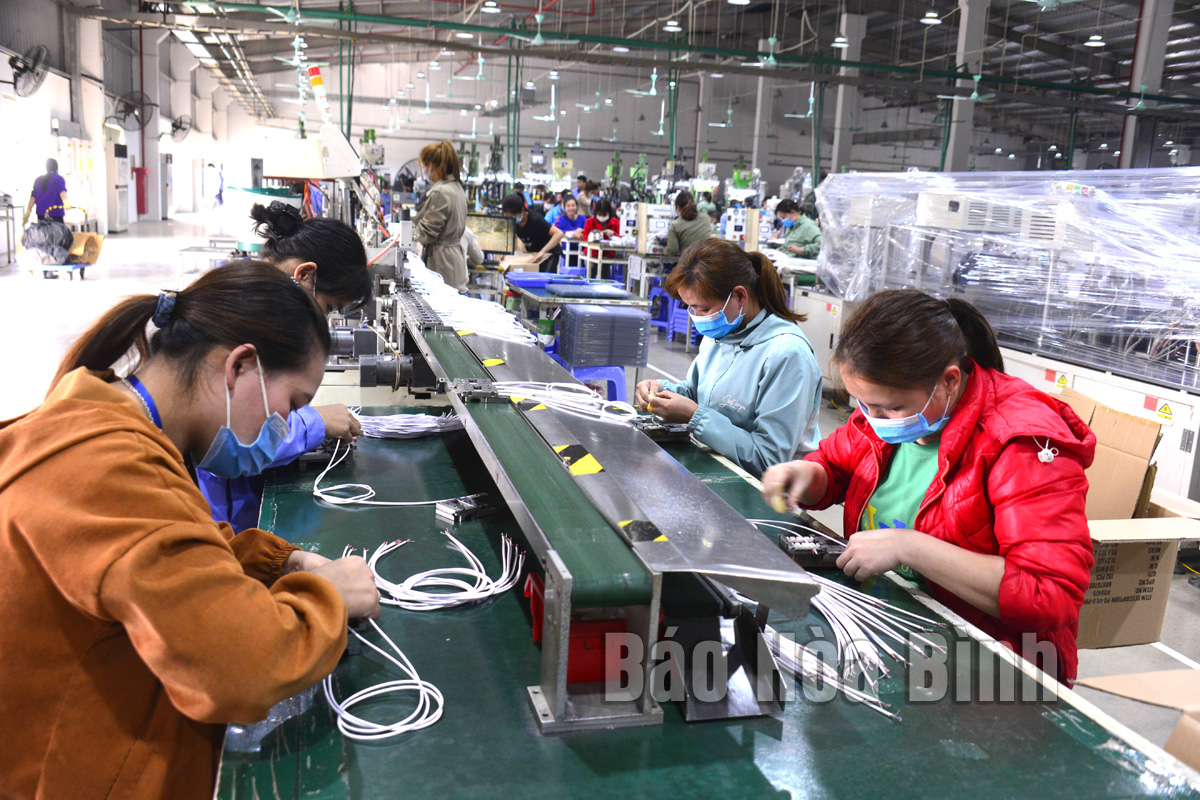
(HBO) – Authorities in Lac Son district have reviewed and sketched out thematic resolutions on investment attraction, infrastructure development, urban and tourism development, land management, site clearance, personnel work, conservation and promotion of cultural values; and set out key and breakthrough tasks.
Lac Son is the second-largest and most populous district in Hoa Binh. Although it is not included in the province's dynamic economic zone, the district has many opportunities for development.
Lac Son Plastic Company helps create jobs and stable incomes for local labourers
The district’s Party Committee has 48 grassroots Party organisations and 394 Party cells under the grassroots Party committees with 8,438 Party members. Nguyen Ngoc Diep, Secretary of the district’s Party Committee said in its socio-economic development strategy, the district has its own potential and advantages for development.
The district has paid attention to the Party and political system building, recording positive results. Since the beginning of the term, eight thematic resolutions have been issued by the district Party Committee to promote leadership in performing political tasks.
The personnel work has been drastically implemented, focusing on the rotation and appointment of cadres. Since the beginning of the term, 70 comrades have been appointed, rotated and nominated for positions under the management of the standing board of the district Party Committee, Diep said.
So far, 20 out of 24 communes and townships in the district have key officials who are not local. The number of Party members admitted every year exceeds the set plan.
The district authorities have also paid heed to improving the quality of inspection, supervision, and mass mobilisation and religious activities; and effectively managing the operation of the Fatherland Front’s chapters and other organisations in the locality.
The locality has recorded positive results in socio-economic development, especially in building new-style rural areas associated with agriculture production. The district has 10 communes meeting all the 19 criteria in order to receive the title of new-style rural commune.
Notably, the district's white sugarcane product has been exported to the US market. Budget revenue, especially revenue from land, has significantly increased. The district has "rolled out red carpet” for investors and supported them in quickly implementing investment procedures in accordance with regulations. It has attracted many strategic investors such as Sun Group, Ho Guom Group, and BKG Vietnam Investment JSC.
Lac Son is seen as a "bright spot" of the province in luring investment. The locality is home to 33 investment projects with a total registered capital of over 11.79 trillion VND (over 501.7 million USD). Many projects have been put into operation, contributing to generating jobs and promoting rural labour restructuring.
The local authorities have also focused on promoting urbanization. So far, the district People’s Committee has implemented the development and management of 34 projects and plans.
The district’s per capita income is set to reach 70 million VND per year, while the State budget revenue is expected to hit 170 billion VND by 2025./.
Hoa Binh province is undergoing a dynamic transformation amid Vietnam’s national digital transition. Building on Poliburo’s Resolution No. 57-NQ/TW on breakthroughs in science, technology, innovation, and national digital transformation, the province has rolled out a wide range of practical action plans. A standout initiative is the "Digital Literacy for All” movement, an effort to ensure that no one is left behind in the digital era.
Hoa Binh province is undergoing a dynamic transformation in the wake of the national digital transformation movement. Building on Resolution No. 57-NQ/TW of the Politburo on breakthroughs in science, technology, innovation, and national digital transformation, the province has implemented a wide range of practical action plans. A standout initiative is the "Digital Literacy for All” movement ambitious effort to ensure that no one is left behind in the digital age.
With a spirit of unity and proactive problem-solving, the Party Committee, the government and the people of Dong Lai Commune (Tan Lac District) have made great strides in implementing the resolutions of the 24th Party Congress of the commune for the 2020 - 2025 term. Focusing on leadership and practical actions, the commune has brought the Party’s resolutions into daily life, creating strong impacts and pushing the local development forward.
Amid the nationwide push for digital transformation, young people in Hoa Binh Province are stepping up as dynamic pioneers, applying technology to enhance Youth Union operations and expand the reach of youth-led initiatives. Through creativity and adaptability, Youth Union organizations at all levels have introduced a series of practical solutions, contributing to modern governance and community development.
In recent years, An Nghia commune, located in Lac Son district, has stepped up administrative reform, focusing on improving the quality and efficiency of its single-window service unit for receiving and processing administrative procedures. These improvements have helped create favourable conditions for local residents and organisations to handle administrative procedures, contributing to the commune’s broader socio-economic development.
The Prime Minister-approved master plan to develop the multi-use value of forests ecosystems through 2030, with a vision to 2050, aims to improve the management and sustainable use of forest resources, create jobs, increase incomes, and improve the living standards of ethnic minorities, people in mountainous and remote areas, forest workers and those living near forests.



